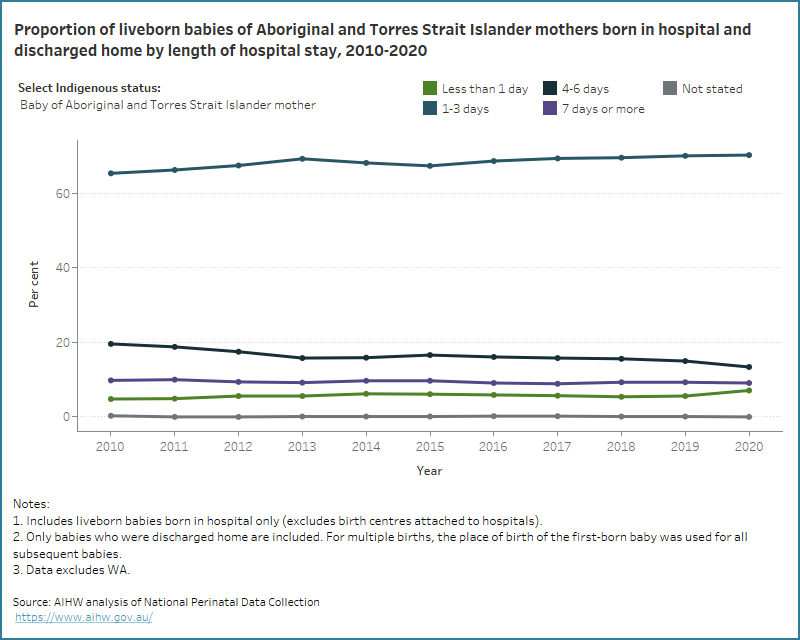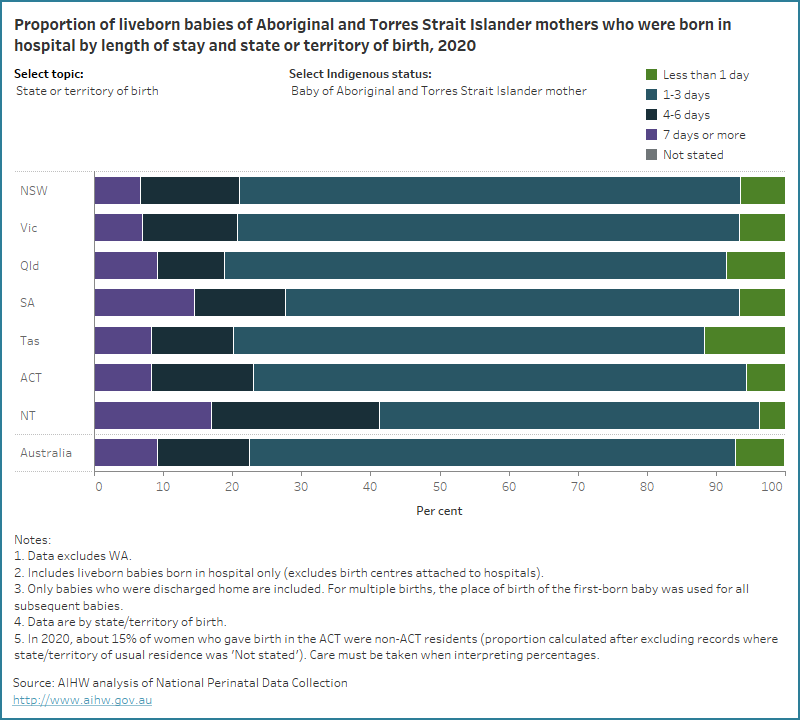 Baby length of stay in hospital
Baby length of stay in hospital
Babies’ length of stay refers to the number of days between the date of birth and the date of discharge. Data on length of stay are based on liveborn babies who were born in hospital and were discharged home and excludes data from Western Australia.
In 2020, 7.1% of babies of Aboriginal and Torres Strait Islander mothers had a stay of less than 1 day, 70% had a stay of 1-3 days, 13% had a stay of 4-6 days and 9.1% had stay of 7 days or more (compared with 5.2%, 66%, 25% and 4.6%, respectively, of babies of non-Indigenous mothers).
Between 2010 and 2020 the length of stay for babies of Aboriginal and Torres Strait Islander mothers has shortened, with an increase in hospital stays of 3 days or less (from 70% in 2010 to 77% in 2020) and a decrease in hospital stays of 4 days or more (from 29% in 2010 to 23% in 2020).
There were changes during this period for stays of less than 1 day (from 4.8% in 2010 to 7.1% in 2020), 1-3 days (from 65% in 2010 to 70% in 2020), 4-6 days (from 20% to 13%). Hospital stays of 7 days or more fluctuated, ranging from 10% to 8.9%.
The data visualisation below shows the proportion of liveborn babies of Aboriginal and Torres Strait Islander mothers and non-Indigenous mothers who were born in hospital and discharged home by grouped length of stay in hospital from 2010, and the proportion of liveborn Aboriginal and Torres Strait Islander babies and non-Indigenous babies who were born in hospital and discharged home by grouped length of stay in hospital from 2013.
Figure 1: Proportion of babies of Aboriginal and Torres Strait Islander mothers, babies of non-Indigenous mothers, Aboriginal and Torres Strait Islander babies and non-Indigenous babies born in hospital and discharged home, by length of hospital stay from 2010 to 2020
Line graph of length of baby stay in hospital by Indigenous status. Most babies of Aboriginal and Torres Strait Islander mothers had a stay of 3 days or less.

In 2020, babies of Aboriginal and Torres Strait Islander mothers were most likely to have a hospital stay of 3 days or less if they were born to mothers who:
-
lived in the second area of socioeconomic disadvantage (80% for quintile 2, compared with between 72% for the least disadvantaged areas (quintile 1))
-
lived in Inner regional areas (81%, compared with 63% for Very remote areas)
-
were aged 20-24 years (81%, compared with 73% for those aged 35-39 years)
-
had a parity of 1 or 3 (both 82%, compared with 72% of first-time mothers)
-
had spontaneous labour (81%, compared with 67% for no labour)
-
had a non-instrumental vaginal birth (84%, compared with 66% for caesarean section birth).
Babies who were born to Aboriginal and Torres Strait Islander mothers were more likely to have a hospital stay of 3 days or less if they were a singleton (79%, compared with 23% of those born as part of a multiple birth), born at term (83%, compared with 22% of those who were born pre-term), had a healthy birthweight (83%, compared with 27% of those born with a low birthweight) or were normal for gestational age (81%, compared with 69% of those who were small for gestational age).
The data visualisation below presents data on grouped length of stay in hospital for liveborn babies of Aboriginal and Torres Strait Islander mothers and Aboriginal and Torres Strait Islander babies who were born in hospital and discharged home, by selected maternal and baby characteristics for 2020.
Figure 2: Proportion of liveborn babies of Aboriginal and Torres Strait Islander mothers and Aboriginal and Torres Strait Islander babies who were born in hospital and discharged home by length of stay and selected topic for 2020
Bar chart for baby stay in hospital by selected topics. 70% of babies of Aboriginal and Torres Strait Islander mothers stayed for 1 to 3 days.



